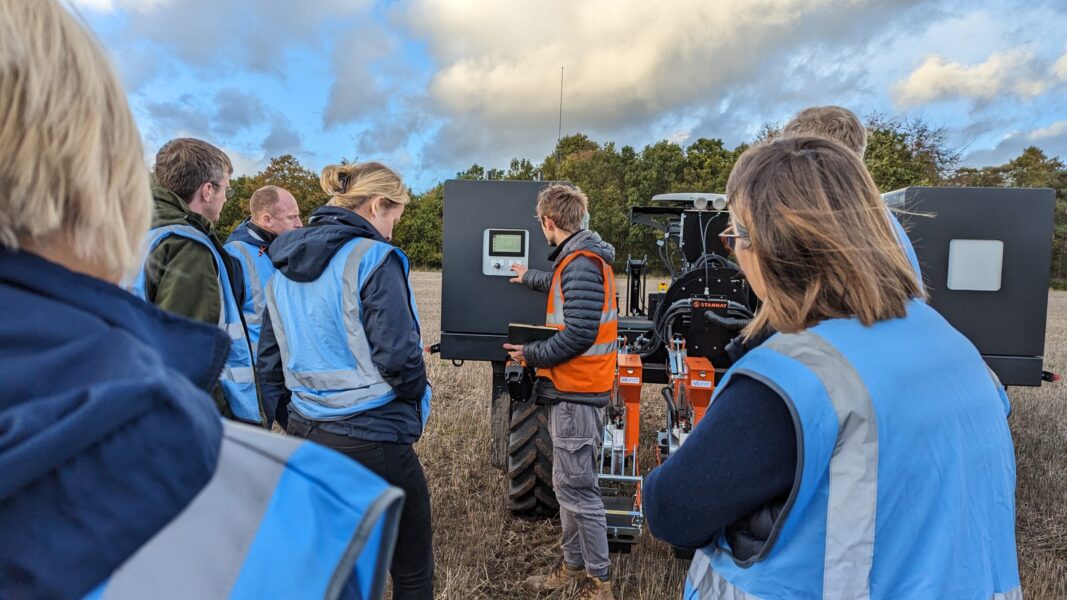Article Written by Michael Pollitt.
Hi-tech and cutting edge technology was driving progress for a long-established Breckland family farm and vegetable business, said managing director Jamie Lockhart.
He welcomed members to the packing operation at Brick Kiln Farm, Brandon, which washes, processes and packs root vegetables including parsnips, potatoes and onions. There has been massive investment in the pack house, especially in automation of repetitive tasks like “crowning” and “top and tailing” of the key parsnip crop.
Mr Lockhart, who became managing director about three years ago, said that Frederick Hiam became a limited company on May 5, 1925 but that the founder had started in business some 30 years earlier.
The farming business has about 7,000 acres in Norfolk and Suffolk plus land, typically on company tenancies, in Cambridgeshire. It has concentrated increasingly on lighter and sandy soils and moved away from the heavier fen soils in the past few years. A recent extension of the business involves growing vegetables and other root crops on 1,000 acres at Tim Jolly’s Roudham farm, he said.
However, the packhouse operation, which employs about 60 full-time staff, was key to the business. Frederick Hiam has concentrated on supplying top quality produce to a range of markets, including also sending daily to London’s Covent Garden. It was also packing produce for other grower enterprises as partnerships have been developed.
Mr Lockhart said that the drive for increased automation, especially in the parsnip operation, was a direct result of the difficulty of recruiting labour. As a result, a new parsnip processing line, utilising techniques and machinery developed in New Zealand, had been successfully introduced. With the challenge of harvesting, washing and preparing parsnips – given that more than 30pc of the crop was sold in just three weeks in December – finding casual labour has become a struggle.
In the recent past, they had to bring casual labour from London for night shift work, which was incredibly costly. In total, precision cutting machinery for “crowning” and “tailing” parsnips had reduced the number of roles by about 20 – and also made the business more competitive. An automatic cutting line can “crown” a parsnip every two seconds – without breaks – preparing about 6 tonnes an hour. Each knife will cut about 150,000 roots before the blades have to be replaced. In addition, trimming accuracy was now about 93 to 94pc compared with about 55pc on former manual systems.
Optical scanning was also in operation on an adjoining potato processing line although again, there were still roles for final visual quality checks.
There has also been big investment in solar panels, producing about 1.5Mw, which has substantially reduced soaring electricity bills although the planning and regulatory process proved very challenging. Interestingly, panels have now been fitted to the north side of buildings despite the lower solar yield compared with south-facing aspects. The new panels yield 17pc more than the much older southerly ones.
In field operations, Frederick Hiam has introduced robots for drilling and in-crop weed control. This summer, the two-metre Robotii, each weighing three tonnes, drilled and weeded about 40ha of parsnips. There was some anxiety, when after extensive trials, the Robotii went “live” and unsupervised. As Mr Lockhart admitted: “We were more than a little nervous. They started at 7.30pm and when we returned the next morning at 6.30am, they had done the work.”
The visitors were also shown precision crop sprayers, which again used the latest smart technology to identify weeds in the growing crops. A tiny dose of a crop protection production could be applied – with precision and at a low rate – through the 156 nozzles of each three-metre unit. As the sprayer was enclosed, it prevented drift and made it possible to operate in a light, windy conditions.








